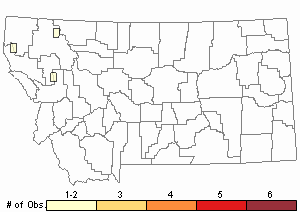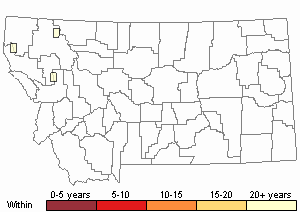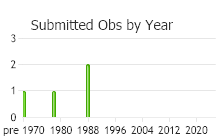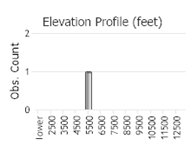View in other NatureServe Network Field Guides
NatureServe
Montana
Utah
Wyoming
Idaho
Wisconsin
British Columbia
South Carolina
Yukon
California
New York
Spreading Shaggy Moss - Rhytidiadelphus squarrosus
General Description
Plants: Pleurocarpous (Vitt 1988), growing in open mats (Crum and Anderson et al. 1981), to 15 cm in length, soft (FNA 2014), not stiff, pale green to green with yellow tones (Lawton 1971) or vivid green, a little glossy, with somewhat reddish stems (Crum and Anderson et al. 1981). Stems creeping or ascending (Lawton 1971), primary stem growth seldom limited (not often dividing) with perichaetia and perigonia lateral; branches distant and erratically spaced to somewhat pinnate, sometimes reaching 12 mm in length; paraphyllia lacking; pseudoparaphyllia leaf-like (FNA 2014).
Stem Leaves: Overlapping below (Lawton 1971) but otherwise not usually crowded (Crum and Anderson et al. 1981) or crowded so as to hide the stem, typically spreading 90 degrees with the ends curved back and down, 2.4-4.2 mm in length, sometimes reaching 1.9 mm in width, pleated below, neither wavy across the leaf nor pleated, egg-shaped from a base somewhat enveloping the stem, narrowed above to form a long, grooved acumen (FNA 2014); leaf edges finely-toothed above (Crum and Anderson et al. 1981); costa extending to about 33% of the leaf length (FNA 2014), double, sometimes lacking (Lawton 1971).
Branch Leaves: Egg- to lance-shaped, typically smaller than the stem leaves (Lawton 1971), a little more densely-spaced and not so widely spreading (Crum and Anderson et al. 1981).
Leaf Cells: Medial laminal cells smooth (FNA 2014), those more distal longer and narrower than those below (Lawton 1971); basal laminal cells longer and narrower than alar cells; alar cells swollen, not porose, the alar region distinct (FNA 2014).
Diagnostic Characteristics
Rhytidiadelphus loreus, although very much alike in appearance to R. squarrosus, has pleated leaves and its alar cells are not particularly distinct from the adjacent cells (Crum and Anderson et al. 1981).
Range Comments
North American Range
AK, BC to OR, NL (FNA 2014). Known in Montana from Flathead, Lake, Lincoln, and Missoula Counties (Elliott and Pipp 2016).
Observations in Montana Natural Heritage Program Database
Number of Observations: 7
(Click on the following maps and charts to see full sized version)
Map Help and Descriptions
Relative Density

Recency



 (Observations spanning multiple months or years are excluded from time charts)
(Observations spanning multiple months or years are excluded from time charts)
Habitat
Open brushy areas, exposed to moderately-shaded (FNA 2014) soil, humus, decaying wood including that in forested swamps, grassy disrupted areas such as grazing land, lawns, beside roads and trails; residing in acidic and basic conditions (Crum and Anderson et al. 1981). Occurring from lowlands to 980 feet (FNA 2014).
Reproductive Characteristics
Dioicous with female plants resembling male plants. Seta about 20 mm tall (Lawton 1971), smooth. Capsule level, sometimes reaching 2.2 mm in length (FNA 2014), russet, creased or pleated when dry; exostome russet (Lawton 1971) with transverse fine lines or a network of them below; endostome processes with wide openings on the keel. Calyptra draping in cowl-like fashion, smooth and hairless (FNA 2014).
Stewardship Responsibility
References
- Literature Cited AboveLegend:
 View Online Publication
View Online Publication Crum, H.A. and L.E. Anderson. 1981. Mosses of Eastern North America. 2 volumes. Columbia University Press, New York. 1328 pp.
Crum, H.A. and L.E. Anderson. 1981. Mosses of Eastern North America. 2 volumes. Columbia University Press, New York. 1328 pp. Elliott, J.C. and A.K. Pipp. 2018. A Checklist of Montana Mosses (1880-2018). Updated 3 January, 2020. Montana Natural Heritage Program, Helena, Montana. 73 pp.
Elliott, J.C. and A.K. Pipp. 2018. A Checklist of Montana Mosses (1880-2018). Updated 3 January, 2020. Montana Natural Heritage Program, Helena, Montana. 73 pp. Flora of North America Editorial Committee, eds. 2014. Flora of North America North of Mexico. Volume 28. Bryophytes: Mosses, Part 2. Oxford University Press, Inc., NY. xxi + 702 pp.
Flora of North America Editorial Committee, eds. 2014. Flora of North America North of Mexico. Volume 28. Bryophytes: Mosses, Part 2. Oxford University Press, Inc., NY. xxi + 702 pp. Lawton, E. 1971. Moss Flora of the Pacific Northwest. Hattori Botanical Laboratory. Japan: Yamabuki-cho, Shinjuku-ku, Tokyo. 362 pages plus appendices.
Lawton, E. 1971. Moss Flora of the Pacific Northwest. Hattori Botanical Laboratory. Japan: Yamabuki-cho, Shinjuku-ku, Tokyo. 362 pages plus appendices. Vitt, D. J. Marsh, and R. Bovey. 1988. Mosses, Lichens & Ferns of Northwest North America. Seattle, WA: University of Washington Press. 296 p.
Vitt, D. J. Marsh, and R. Bovey. 1988. Mosses, Lichens & Ferns of Northwest North America. Seattle, WA: University of Washington Press. 296 p.
- Additional ReferencesLegend:
 View Online Publication
View Online Publication
Do you know of a citation we're missing? Elliot, J. C. 1993. Second checklist of Montana mosses. Unpublished report. U.S. Forest Service, Region 1. Missoula, MT. 45 pp.
Elliot, J. C. 1993. Second checklist of Montana mosses. Unpublished report. U.S. Forest Service, Region 1. Missoula, MT. 45 pp. Lawton, E. 1971. Keys for the Identification of the Mosses on the Pacific Northwest. Reprinted from 'Moss Flora of the Pacific Northwest'. Published as Supplement No. 2 of the Journal of the Hattori Botanical Laboratory. Nichinan, Miyazaki, Japan. 66 pp.
Lawton, E. 1971. Keys for the Identification of the Mosses on the Pacific Northwest. Reprinted from 'Moss Flora of the Pacific Northwest'. Published as Supplement No. 2 of the Journal of the Hattori Botanical Laboratory. Nichinan, Miyazaki, Japan. 66 pp. Malcolm, B., N. Malcolm, J. Shevock, and D. Norris. 2009. California Mosses. Nelson, New Zealand: Micro-Optics Press. 430 pp.
Malcolm, B., N. Malcolm, J. Shevock, and D. Norris. 2009. California Mosses. Nelson, New Zealand: Micro-Optics Press. 430 pp. Smith, A.J.E. 1980. The Moss Flora of Britain and Ireland. Cambridge University Press, Cambridge. 705 pp.
Smith, A.J.E. 1980. The Moss Flora of Britain and Ireland. Cambridge University Press, Cambridge. 705 pp.
- Web Search Engines for Articles on "Spreading Shaggy Moss"





